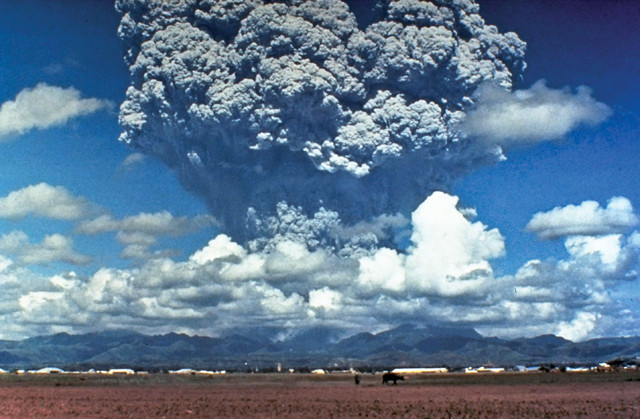
by Mary Caperton Morton Tuesday, February 9, 2016

Large volcanic eruptions, like the 1991 eruption of Mount Pinatubo in the Philippines, can affect river flow rates around the world. Credit: Dave Harlow, U.S. Geological Survey.
Volcanic eruptions are some of the most powerful agents of climate change on the planet, with some very large events impacting global weather for up to a decade after an eruption. A new study highlights some of the indirect effects of large eruptions, such as how they impact rivers around the world.
When Mount Pinatubo erupted in the Philippines in 1991, the blast sent more than 20 million tons of ash and sulfur dioxide high into the stratosphere. The particulate matter blocked the sun’s incoming rays and global temperatures dropped on average by 0.5 degrees Celsius for three years. Studies following the eruption showed that precipitation also decreased over much of the planet, particularly in wetter tropical regions.
The new study, published in Nature Geoscience, goes one step further, using flow-rate records for 50 major rivers, including the Congo, the Amazon and the Colorado, for a continuous time period spanning six major eruptions, including Krakatoa in 1883, El Chichón in 1982 and Pinatubo in 1991, to study the effects of eruptions on rivers.
“Despite the importance of rivers to people, it has been unclear whether volcanism causes detectable changes in streamflow, given large natural variability of rivers. This is the first study to look at rivers in this way on a global scale,” says Carley Iles, a climatologist at the University of Edinburgh in Scotland and lead author of the study.
Drawing upon observational river-flow records collected through the 19th and 20th centuries by water management, agricultural and research groups for varying purposes, Iles and co-author Gabriele Hegerl, also at the University of Edinburgh, grouped rivers by region to help tease out the effect of volcanoes from the myriad other factors that can impact river-flow patterns. “Rivers are highly variable … so it was difficult to see what the influence of the volcanoes was when looking at the rivers individually,” Iles says. “Grouping the rivers across regions helped filter out some of the noise [from other sources of variability] and made the effects of the eruptions clearer.”
The researchers found that large eruptions were followed by significant streamflow changes worldwide, although the changes varied by region. For example, in the tropics, some rivers saw reduced flows for a year or two after the event: The Amazon and Nile decreased in flow by about 10 percent after major eruptions. Others in drier regions like the U.S. Southwest and southern South America saw increases in flow; flows in the Rio Negro and Rio Colorado of southern South America, for example, increased as much as 25 percent. This pattern of drier tropics and wetter subtropics following eruptions has been observed before in climate models, Iles says, and has to do with disruptions in atmospheric circulation patterns after eruptions. In particular, weakening is observed in Hadley Cells, which are associated with rising air and seasonally heavy rainfall in the tropics and descending air and dry conditions in the subtropics.
The results are not surprising, says Robert Adler, a climatologist at the University of Maryland who was not involved in the new research. “There’s no doubt that volcanoes affect rainfall patterns, but it’s interesting to see the impact on rivers documented in this way,” he says. “Not many people have done this kind of study for rivers, specifically. It can be tricky to tease this kind of information out of observations that were made for other purposes.”
Rivers are important influences on both ecosystems and people, as they’re harnessed for domestic use, agriculture, industry and power generation, Iles and Hegerl noted in the study.
“Our findings suggest that future volcanic eruptions could substantially affect global water availability,” they wrote. A better understanding of the regions that are more likely to be affected after major eruptions may help mitigate the impacts of volcanoes, Iles says.
© 2008-2021. All rights reserved. Any copying, redistribution or retransmission of any of the contents of this service without the expressed written permission of the American Geosciences Institute is expressly prohibited. Click here for all copyright requests.